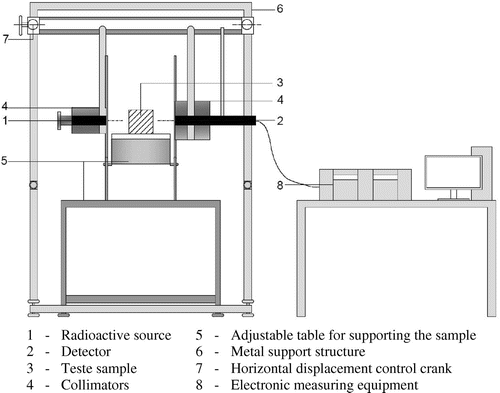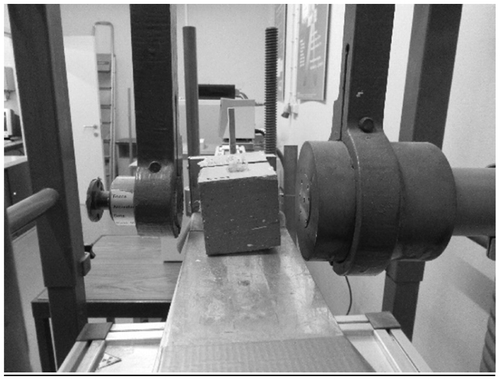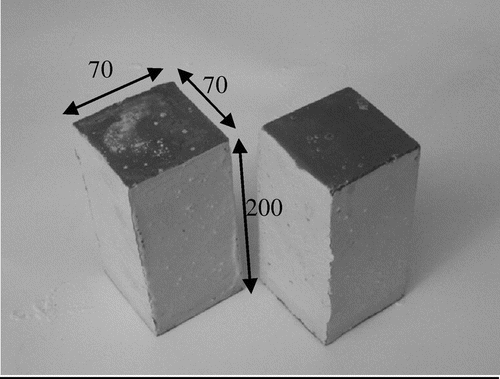 ?Mathematical formulae have been encoded as MathML and are displayed in this HTML version using MathJax in order to improve their display. Uncheck the box to turn MathJax off. This feature requires Javascript. Click on a formula to zoom.
?Mathematical formulae have been encoded as MathML and are displayed in this HTML version using MathJax in order to improve their display. Uncheck the box to turn MathJax off. This feature requires Javascript. Click on a formula to zoom.Abstract
The study of moisture transfer in porous building materials after a long contact with liquid water is crucial to prevent damages, in particular, when it comes to extreme rain events or floodings. Several experimental techniques are available to measure the moisture content evolution during water absorption tests, although the great majority of them are time-consuming and require expensive equipment. For this reason, the use of validated hygrothermal simulation tools is essential for a faster analysis without losing accuracy. The main goal of this paper is to compare the simulated moisture content profiles provided by the program TRHUMIDADE with those obtained by the gamma-ray attenuation method and by WUFI program. In TRHUMIDADE the heat and moisture phenomenon is described by the moisture content gradient, which may be more appropriate in predicting scenarios involving liquid water transport. The obtained results showed a good agreement for the red-brick and the autoclaved cellular concrete, which contributes to validate the future use of the program in the development of advanced hygrothermic studies in multi-layered building walls.
Public Interest Statement
This paper represents an important contribution to the development of a numerical simulation program–TRHUMIDADE—which allows the study of the heat and moisture transfer inside the building materials.
The knowledge of water transport in the inner parts of the materials and construction building elements is of great importance for its behaviour characterization, especially for its durability, waterproofing, degradation appearance and thermal performance. It also has an important role in the correct diagnosis of the buildings pathologies’ causes related to moisture presence, allowing the adoption of appropriate intervention measures.
Since humidity is one of the most frequent causes of pathologies, fungi and moulds in buildings, the development of simulation tools, which allow a rapid prediction and correction of the these pathologies is an important issue for both scientists in the area and for professional practice.
Competing interests
The authors declare no competing interest.
1. Introduction
The study of moisture transfer in building materials and components is crucial to predict and avoid several damages and is essential to increase the durability of the porous materials in building structures (de Freitas, Citation1992; Guimarães, Delgado, & de Freitas, Citation2010; Mendes & Philippi, Citation2004). There are several experimental methods available to determine the evolution of moisture content profiles in porous building materials. Although some of these methods do not involve the destruction of the test sample each time the moisture profile is measured (non-destructive methods), they are usually time consuming and require expensive equipment. Some of the most common procedures are described in Table .
Table 1. Most common procedures to determine moisture content profiles in porous building materials
Despite the variety of the available experimental techniques, the use of hygrothermal simulation programs allows a faster study of the water absorption process in porous building materials when compared with the time spent and the materials required in the experimental methods. Although most of these programs require the introduction of a vast number of material properties that often have to be determined by time-consuming experimental procedures, a few studies revealed that some properties have a limited influence on the results and therefore it is possible to avoid the time spent in their determination without any difference on the results (Guimarães, Ribeiro, & de Freitas, Citation2017a).
This paper aims to evaluate the results of an hygrothermal simulation program—TRHUMIDADE—by comparing the moisture content profiles obtained for two porous materials with those provided by the gamma-ray attenuation method and also by the well known simulation program WUFI Pro. One of the characteristics that distinguishes the simulation program TRHUMIDADE from other available programs is that it is based on water content potential, which may prove to be more appropriate to describe scenarios involving high moisture content values, providing more accurate results in predicting liquid water transport (Delgado, Ramos, Barreira, & de Freitas, Citation2010; de Freitas, Citation1992; Janz & Johannesson, Citation2001; Mendes & Philippi, Citation2004).
2. Experimental methodology
For the study carried on in this paper the gamma-ray attenuation method was used to obtain the experimental moisture content profiles of two materials: the red brick and the autoclaved cellular concrete (ACC). Immediately before being placed in the gamma-ray equipment the samples are subjected to a water absorption process test according to the procedures presented in the international standard, ISO 15148, (Citation2002). As mentioned above, the principle of this technique consists in the emission of gamma radiation against the material sample in test. The intensity of a narrow beam of gamma rays passing through a material can be expressed by:(1)
(1)
where:
I: Intensity of the received gamma radiation [counts/s]
I 0: Intensity of the emitted gamma radiation [counts/s]
µ: Mass attenuation coefficient [m2/kg]
ρ: Bulk density [kg/m3]
χ: Specimen thickness [m]
As porous building materials the red brick and the autoclaved cellular concrete incorporate a solid and a liquid phase. For the experimental tests the specimens are additionally involved by other materials and therefore the Equation (1) must be extended to include the following components:(2)
(2)
where:
µ i : Envelope material attenuation coefficient, i [m2/kg]
ρ i : Bulk density of the envelope materials i [kg/m3]
χ i : Thickness of envelope materials i [m]
µ 0: Porous structure material attenuation coefficient [m2/kg]
ρ 0: Bulk density of the porous material under study [kg/m3]
d: Thickness of the porous material under study [m]
ξ: Porosity [%]
µ w : Water attenuation coefficient [m2/kg]
ρ w : Water bulk density [kg/m3]
S w : Degree of saturation [%]
The intensity of the received radiation through a completely dry sample– can be measured and replaced in the Equation (2), which therefore assumes the following expression:
(3)
(3)
Two different procedures were used to determine the experimental moisture content profiles using both of them the Equation (3) as starting point:
| • | Based on the knowledge of the water attenuation coefficient, μ
w
and the dry bulk density of the material, ρ
0 it′s possible to obtain the moisture content by solving the Equation (3) in order to obtain the moisture ratio by volume | ||||
(4)
(4)
| • | With a completely saturated sample the intensity of the received radiation is measured—I sat and consequently Equation (5) can be written: | ||||
(5)
(5)
When replaced in equation (3) the following relation for the saturation degree is obtained:
(6)
(6)
Finally, the moisture content U (kg/kg) is achieved when the saturation degree is multiplied by the saturation moisture content (U = S w .U sat ).
The use of the second procedure to calculate the experimental moisture content profiles ensure more accurate results since less properties that could bring errors to the measurements are used. However for certain materials, as the autoclaved cellular concrete, the saturation moisture content, U sat is very difficult to obtain. For this reason, the moisture content profiles of the autoclaved cellular concrete were calculated according to the first procedure presented while the second methodology was used for the red brick.
The experimental equipment used in the tests was developed by Vasco Freitas at the Faculty of Engineering–University of Porto, FEUP (de Freitas, Citation1992). It is mainly composed by: a radioactive source of Am241, a crystal detector of sodium iodide, a set of electronic measuring equipment for counting the number of impulses throughout the experience and a support structure that ensures the attached movement of the detector and the source in the horizontal direction.
The radioactive source and the detector are inserted into collimators in order to minimize the particles spread. A scheme of the used equipment is represented in Figure .
The samples, placed between the source and the detector (Figure ), have a prismatic shape with a rectangular section of 70 × 70 mm2 and 200 mm high. Each specimen was sealed with epoxy resin on their longitudinal faces to ensure that only a unidirectional moisture flow is created (Figure ). The use of this sealant does not imply any changes in the moisture content measurement, taking into account its very low mass and constant thickness.
For both tested materials the moisture content measurements at a specific time and thickness are the result of an average of five readings, each with a variable duration in time according to the material density, in order to reduce the consequences of the aleatory photons emissions.
2.1. Experimental results
The experimental moisture content profiles obtained for the red brick and for the autoclaved cellular concrete (ACC) are presented in Figures and , respectively.
Figure 4. Experimental moisture content profiles of the red brick provided by gamma-ray attenuation method.

Figure 5. Experimental moisture content profiles of the autoclaved cellular concrete (ACC) provided by gamma-ray attenuation method.
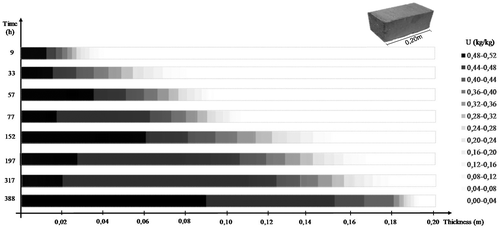
Those graphics were obtained by fitting a linear or polynomial trend line to the set of moisture content values measured along the sample. Each profile was measured at a specific hour during the absorption test, which was performed in isothermal conditions, T amb = 25 °C, with 50% of relative humidity, RH amb , according to the international standard (ISO 15148, Citation2002 ), as above mentioned. Everytime a moisture content profile is desired, the absorption test is interrupted, the water adhering to the surface and not absorbed is removed and the sample is placed in the gamma-ray equipment. This procedure ends when the progression of the wet front stabilized in the material specimen.
The experimental moisture content profiles achieved for both materials revealed, as it was to be expected, a continuous advance of the wet front along the time. However, in the case of the autoclaved cellular concrete (ACC), small variations on the progression of the high moisture content values along the time were recorded, which may be due to the heterogeneous porous structure of this material. In addition, the small amplitude of the defined moisture content intervals and the adjustments made (linear or polynomial) makes that small variations in the recorded values belong to another moisture content interval, which amplify the observed variations.
3. Numerical analysis
3.1. Simulation with WUFI Pro
WUFI Pro is a one-dimensional program developed by the Fraunhofer Institute for Building Physics—IBP—to perform dynamic simulations of coupled heat and moisture transfer, where the relative humidity (RH) gradient is used as driving force for heat and moisture calculations. The program has been validated worldwide providing realistic results in terms of the hygrothermal performance in different building components under real climate conditions (WUFI Pro 5.2, Citationn.d.). The governing equations for moisture and energy transfer are, respectively:(7)
(7)
(8)
(8)
where,
W: Moisture content [kg/m3]
RH: Relative humidity [%]
t: Time [s]
D φ : Liquid conduction coefficient [kg/ms]
δ P : Vapour permeability [kg/ms Pa]
p sat : Saturation vapour pressure [Pa]
H: Total enthalpy [J/m3]
T k : Temperature [K]
: Thermal conductivity [W/mK]
h v : Latent heat of phase change [J/kg]
In this work, the program was used to obtain the moisture content profiles of the red brick and the autoclaved cellular concrete under the same conditions of the experimental tests performed with the gamma-ray attenuation method. Each simulation involved the introduction of the following material properties: bulk density, ρ [kg/m3], specific heat capacity, C 0 [J/kg.K], porosity, ξ [m3/m3], sorption isotherm, dry thermal conductivity at 10 °C, λ [W/m.K], liquid transport suction coefficient, D WS [m2/s], and finally the water vapour diffusion resistance factor, μ [−]. Table show the hygrothermal properties that were introduced in the WUFI Pro for the both materials studied (de Freitas, Citation1992; Freitas & Pinto, Citation1998).
Table 2. Hygrothermal properties of the materials used in the WUFI Pro simulations
3.2. Simulation with TRHUMIDADE
A one-dimensional program created to analyse the heat and moisture transport through building elements—TRHUMIDADE–was developed at Faculty of Engineering–University of Porto, FEUP (de Freitas, Citation1992). The program is based on the mathematical model proposed by Luikov and Philip—De Vries and has the following equations for mass and energy transfer, respectively:
(9)
(9)
(10)
(10)
where,
U(x, t): Moisture content [kg/kg]
T(x, t): Temperature [ºC]
D w (U): Hydric diffusivity [m2/s]
D T (U): Thermal diffusivity [m2/(s.K)]
: Thermal conductivity [W/(m.K)]
C 0: Specific heat capacity of a dry material [J/(kg.K)]
ρ 0: Bulk density of a dry material [kg/m3]
Unlike WUFI, this program uses the moisture content gradient to calculate the heat and moisture transport. Despite the difficulties inherent to this type of programs whenever it is intended to analyse the interface between two different porous materials (Freitas, de Abrantes, & Crausse, Citation1996; Qin, Belarbi, Aït-Mokhtar, & Nilsson, Citation2009), some studies have already shown that moisture content gradients can be successfully used to describe the phenomenon (de Freitas, Citation1992; Guimarães et al., Citation2017; Mendes & Philippi, Citation2004). Furthermore, more accurate results are expected for scenarios involving high moisture content values. Each simulation demands the introduction of the following material properties: dry bulk density, ρ 0 [kg/m3], specific heat capacity, C 0 [J/kg.K], porosity, ξ [m3/m3], sorption isotherm, thermal conductivity, λ [W/m.K], hydric diffusivity, D W [m2/s], and at last the thermal diffusivity, D T [m2/s.K]. For each material, all the properties depending on moisture content or temperature must be introduced in the program according to the same set of moisture content values in the shape of a matrix. Table shows the hygrothermal properties (de Freitas, Citation1992) that were used in the TRHUMIDADE simulations.
Table 3. Hygrothermal properties of the materials used in the TRHUMIDADE simulations
4. Discussion
In the performed study, the experimental moisture content profiles were used as a reference to evaluate the TRHUMIDADE results. Therefore, a greater similarity between the simulated profiles and the experimental profiles is pursued and considered a better agreement. This criterion is based on the good accuracy of the gamma-ray attenuation method recognized by several authors (de Freitas, Citation1992; Guimarães, Ribeiro, & de Freitas, Citation2017b; Nizovtsev, Stankus, Sterlyagov, Terekhov, & Khairulin, Citation2008; Roels et al., Citation2004), in the possibility to obtain the moisture content profiles almost continuously in space and because this experimental technique allows preserving the porous structure of the specimens during the tests. On the other hand, the moisture content profiles provided by WUFI Pro were also a very important reference for the TRHUMIDADE results, taking into account the wide validation and use of this program in the last years (Capener, Burke, & Stephan Ott, Citation2014; Villmann, Slowik, Wittmann, Vontobel, & Hovind, Citation2014).
Figures and show the comparison between the experimental and numerical results obtained for the red brick and for the autoclaved cellular concrete. The moisture content profiles achieved with the two different programs showed a good agreement with each other for both materials, taking into account their distinct characteristics (they are based on different equations to describe the heat and moisture transportation without using exactly the same material properties). The comparison between the simulated and experimental profiles was also positive, especially between the values achieved with the TRHUMIDADE and the γ-ray test.
Figure 6. Comparison of the moisture content profiles on red brick obtained by gamma-ray (γ-ray), WUFI Pro (WUFI) and TRHUMIDADE (TRH).
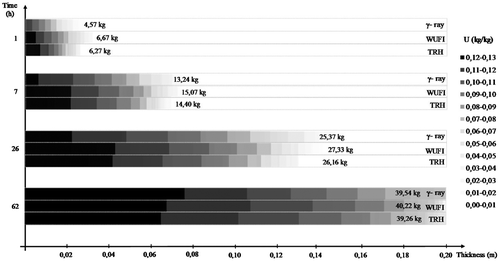
Figure 7. Comparison of the moisture content profiles on autoclaved cellular concrete (ACC) by gamma-ray (γ-ray), WUFI Pro (WUFI) and TRHUMIDADE (TRH).
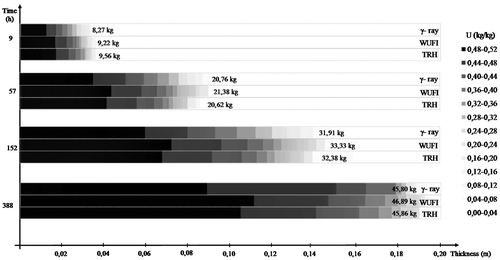
The total amount of water absorbed by the materials was calculated for a more accurate comparison of the results, by multiplying the dry bulk density, ρ 0, for the area below the moisture content profile at every hour under study (Figure ). The calculated area include the total amount of water absorbed for high and low moisture content values, and therefore all the colour shades defined in the constructed bar charts are taken into account. The obtained results are included in Figures and and reveal that after a long time in contact with liquid water the program TRHUMIDADE provide closer results to the experimental ones. In addition, the performed study also enables to realize that the progression of the wet front for high moisture values can be better describe by the program TRHUMIDADE, as it happens with the autoclaved cellular concrete (ACC), specially for extended simulation periods (Figure ). Despite the promising results, only further studies with different materials will allow to conclude in which precise circumstances the program TRHUMIDADE could add further value for moisture transfer analysis.
5. Conclusions
There are many experimental methods available for studying the water absorption process in porous building materials, although the great majority of them is time-consuming and require expensive equipment. For this reason, the use of validated hygrothermal simulation programs is getting more and more important for a faster prediction of the phenomenon. In this study, the results provided by the program TRHUMIDADE were validated by comparing them with the gamma-ray hydric profiles and moisture content profiles given by WUFI Pro for two porous materials: the red brick and the autoclaved cellular concrete (ACC). The three different moisture content profiles (gamma-ray, WUFI and TRHUMIDADE) showed a good agreement for the two different studied materials. In addition, the moisture content profiles obtained with TRHUMIDADE have proved to be closer to the experimental results, especially for very high moisture contents, as it happens in the autoclaved cellular concrete (ACC). In this way, the TRHUMIDADE program proved to be an efficient tool for the study of water absorption processes, providing results closer to the experimental ones for high moisture content values.
6. Future developments
In the near future it is intended to continue the study of TRHUMIDADE for multilayer building elements in closer conditions to the reality. More accurate results for scenarios involving high moisture content values are expected with TRHUMIDADE when compared to other existing programs. In this way, the TRHUMIDADE program appears to be a very useful tool for the development of advanced hygrothermal simulation studies in a wide range of practical situations.
| Notations | ||
| amb | = | Ambience |
| ACC | = | Autoclaved cellular concrete |
| ρ | = | Bulk density [kg/m3] |
| ρ 0 | = | Bulk density of dry material [kg/m3] |
| ρ i | = | Bulk density of the envelope material, i [kg/m3] |
| S | = | Capillary suction [Pa] |
| S w | = | Degree of saturation [%] |
| µ i | = | Envelope material attenuation coefficient, i [m2/kg] |
| D W | = | Hydric diffusivity [m2/s] |
| I 0 | = | Intensity of the emitted γ-radiation [counts/s] |
| I | = | Intensity of the received γ-radiation [counts/s] |
|
| = | ntensity of the received γ-radiation through a completely dry sample [counts/s] |
| I sat | = | Intensity of the received γ-radiation through a completely saturated sample [counts/s] [counts/s] |
| h v | = | Latent heat of phase change [J/kg] |
| D φ | = | Liquid conduction coefficient [kg/ms] |
| DWS | = | Liquid transport suction coefficient [m2/s] |
| µ | = | Mass attenuation coefficient [m2/kg] |
| U | = | Moisture content [kg/kg] |
| W | = | Moisture content [kg/m3] |
| ξ | = | Porosity [%] |
| µ 0 | = | Porous structure material attenuation coefficient [m2/kg] |
| RH | = | Relative humidity [%] |
| U sat | = | Saturation moisture content [kg/kg] |
| p sat | = | Saturation vapour pressure [Pa] |
| C0 | = | Specific heat capacity of a dry material [J/(kg.K)] |
| χ | = | Specimen thickness [m] |
| T | = | Temperature [ºC] |
| T k | = | Temperature [K] |
| t | = | time [s] |
| λ | = | Thermal conductivity [W/(m.K)] |
| D T | = | Thermal diffusivity [m2/(s.K)] |
| χ i | = | Thickness of the envelope material, i [m] |
| d | = | Thickness of the porous material under study [m] |
| H | = | Total enthalpy [J/m3] |
| δ | = | Vapour permeability [kg/ms Pa] |
| µ w | = | Water attenuation coefficient [m2/kg] |
| ρ w | = | Water bulk density [%] |
| µ | = | Water vapour diffusion resistance factor [−] |
Funding
The research work presented herein was supported by FEDER funds through the Operational Programme for Competitiveness Factors - COMPETE; by national funds through the FCT - Portuguese Foundation for Science and Technology - under research project POCI – 01-0145-FEDER-007457.
Additional information
Notes on contributors
A.S. Guimarães
A.S. Guimarães, assistant professor in the Civil Engineering Department of FEUP, since 2008; Member of the “Ordem dos Engenheiros”–Portugal since 2005; PhD since 2011, Civil Engineering mobility coordinator at FEUP, Member of Executive Commission in the Civil Engineering Department. Main research interest: building physics, rising damp, building pathology and building rehabilitation.
I.M. Ribeiro
I.M. Ribeiro, assistant professor in the Civil Engineering Department of FEUP; Pedagogical Coordinator of Civil Engineering Master; Integrated member of CONSTRUCT research unit: Institute of R&D in Structures and Construction. Main research interest: global optimization, complementarity problems and applications of optimization in civil engineering.
T.S. Freitas
T.S. Freitas received the MS degree in Civil Engineering from the Faculty of Engineering University of Porto, Portugal, in 2016. Until July 2017, she has developed work as a researcher in the University. Main research interest: building physics, drying process of building materials, building rehabilitation
References
- Baker, P. H. , Bailly, D. , Campbell, M. , Galbraith, G. H. , McLean, R. C. , Poffa, N. , & Sanders, C. H. (2007). The application of X-ray absorption to building moisture transport studies. Measurement , 40 (9-10), 951–959. doi:10.1016/j.measurement.2006.10.016
- Capener, C.-M. , Burke, S. , & Stephan Ott, A. . (2014). Hygrothermal Performance of TES Energy Façade at two European residential building demonstrations–Comparison between Field Measurements and Simulations. In 10th Nordic Symposium on Building Physics .
- Delgado, J. M. P. Q. , Ramos, N. M. M. , Barreira, E. , & de Freitas, V. P. (2010). A critical review of hygrothermal models used in porous building materials. Journal of Porous Media , 13 , 221–234.10.1615/JPorMedia.v13.i3
- de Freitas, V. P. (1992). Transferência de humidade em paredes de edifícios—Análise do fenómeno de interface ( PhD thesis). FEUP, Porto.
- Freitas, V. P. de Abrantes, V. , & Crausse, P. (1996). Moisture migration in building walls–Analysis of the Interface Phenomena, Building and Environment . The International Journal of Building Science and its Applications , 31 (2), 99–108.
- Freitas, V. P. , & Pinto, P. (1998). Permeabilidade ao vapor de materiais de construção—Condensações internas, Nota de informação técnica—NITº002, lfc.
- Guimarães, A. S. , Delgado, J. M. P. Q. , & de Freitas, V. P. (2010). Mathematical analysis of the evaporative process of a new technological treatment of rising damp in historic buildings. Building and Environment , 45 (11), 2414–2420. doi:10.1016/j.buildenv.2010.05.007
- Guimarães, A. S. , Ribeiro, I. M. , & Freitas, V. P. de (2017a). A tool to predict water absorption in porous building materials. Journal of Porous Media , 20 (2), 127–141.
- Guimarães, A. S. , Ribeiro, I. , & de Freitas, V. P. (2017b). Experimental validation of a hygrothermal simulation tool using gamma ray. Energy Procedia , 132 , 783–788.10.1016/j.egypro.2017.10.030
- ISO 15148 . (2002 ). Hygrothermal performance of building materials and products—Determination of water absorption coefficient by partial immersion . International Stander.
- Janz, M. (1997). Methods of measuring the moisture diffusivity at high moisture levels ( Licentiate thesis). Institute of Technology, Division of Building Materials, Lund.
- Janz, M. , & Johannesson, B. F. (2001). Measurement of the moisture storage capacity using sorption balance and pressure extractors. Journal of Thermal Envelope and Building Science , 24 (4), 316–334.10.1106/VRU2-LNV1-ME9X-8KKX
- Mendes, N. , & Philippi, P. C. (2004). A method for predicting heat and moisture transfer through multi-layered walls based on temperature and moisture content gradients. International Journal of Heat and Mass Transfer , 48 (1), 37–51. doi:10.1016/j.ijheatmasstransfer.2004.08.011
- Nizovtsev, M. I. , Stankus, S. V. , Sterlyagov, A. N. , Terekhov, V. I. , & Khairulin, R. A. (2008). Determination of moisture diffusivity in porous materials using gamma-method. International Journal of Heat and Mass Transfer , 51 (17), 1–2.
- Pel, L. . (1992/1995). Moisture transport in porous building materials ( PhD thesis). FEUP, Porto.
- Pel, L. , Ketelaars, A. A. J. , Adan, O. C. G. , & Van Well, A. A. (1993). Determination of moisture diffusivity in porous media using scanning neutron radiography. International Journal of Heat and Mass Transfer , 36 (5), 1261–1267.10.1016/S0017-9310(05)80095-X
- Pleinert, H. , Sadouki, H. , & Wittmann, F. H. (1998). Determination of moisture distributions in porous building materials by neutron transmission analysis. Materials and Structures , 31 , 218–224.10.1007/BF02480418
- Qin, M. , Belarbi, R. , Aït-Mokhtar, A. , & Nilsson, L. (2009). Coupled heat and moisture transfer in multi-layer building materials. Construction and Building Materials , 23 , 967–975.10.1016/j.conbuildmat.2008.05.015
- Roels, S. , Carmeliet, J. , Hens, H. , Adan, O. , Brocken, H. , Cerny, R. , ... Pel, L. (2004). A comparison of different techniques to quantify moisture content profiles in porous building materials. Journal of Thermal Envelope and Building Science , 27 (4). doi:10.1177/1097196304042117
- Villmann, B. , Slowik, V. , Wittmann, F. H. , Vontobel, P. , & Hovind, J. (2014). Time-dependent moisture distribution in drying cement mortars-results of neutron radiography and inverse analysis of drying tests. Restoration of Buildings and Monuments , 20 (1), 49–62.
- WUFI Pro 5.2 . (n.d.). Online help Fraunhofer – IBP . Germany.

